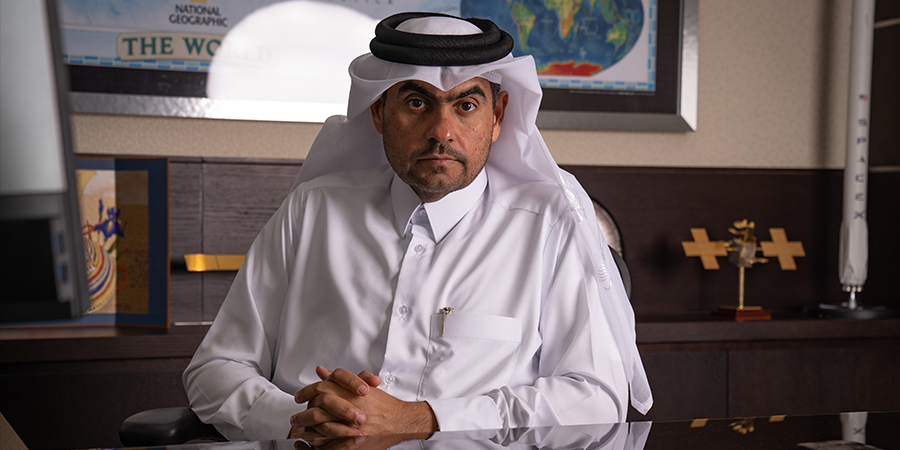In an exclusive with Telecom Review, Ali Ahmed Al-Kuwari, President and CEO, Es’hailSat, talked about the company’s latest telecom offerings and how they nurture talent for the development of Qatar’s satellite technology. Apart from that, Al-Kuwari gave insights to the company’s contribution on mega-event hosting and collaboration with other global and regional satellite operators.
Since the past year, there has been a huge surge in online activities, what have been Es’hailSat’s latest offerings to the telecommunications customers given this change?
Online activities have surged in the last year or two, initially because of the compulsions that arose during the pandemic, but also because people have thereafter realized that a lot can be accomplished online, even if one is not physically present in offices and other locations. The net result of this has been that connectivity has become more critical to the lives and livelihoods of people, and robust telecommunication services are now seen as an essential utility.
Es’hailSat’s state-of-the-art Teleport in Doha was launched officially in 2019 to manage the operations of our satellite and also to support value added services for our customers. To support one such initiative, we have commissioned an iDirect Hub Service at the Teleport to provide fully managed service packages to our end users. This has helped organizations improve their own network and offer services to their end-users providing them with resilient and reliable communication services for the enterprise needs.
How is Es’hailSat contributing to Qatar’s hosting of mega-events in terms of broadband delivery, broadcasting, and global connectivity?
Over the past year, Es’hailSat has signed many strategic partnerships to enable Qatari companies to benefit from the most advanced technologies. We are showcasing some of our partnerships regarding maritime and mobile broadband connectivity at the upcoming Qatar International Boat Show in November 2021. Certain partnerships we now have allow us to offer enhanced VSAT support services in the maritime segment while others cater to communications infrastructure required for vessels at sea. One such example is the successful proof-of-concept that we completed in 2021 using low profile flat panel VSAT terminals for the maritime environment using our Es’hail-1 satellite.
For the various mega-events, especially those broadcast live across the globe, we at Es’hailSat have enhanced our satellite news gathering services capabilities. These, along with our Es’hail-1 and Es’hail-2 satellites at 25.5/26 East hotspot, will provide the backbone required by news broadcasters and television channels to carry these events across the region and beyond.
With the growth in fiber deployments in the region, do you see any challenges rising for the satellite services market, and how do you plan to address those issues?
Fiber connectivity is a crucial enabler for satellite services, and we do not see the regional deployments of fiber as a threat to our business. Having reliable fiber services at the right price allows us to complement that terrestrial infrastructure with our space-based capabilities to provide the end users with a mature, all-inclusive offering that takes advantage of every technology available. Given the remote and sparsely populated areas, and difficult terrain within this region, at present fiber connectivity is largely within and between the major cities. It will remain this way for some time as service providers struggle to find the right balance between expending high CAPEX and providing connectivity to the remote areas.
In the future, as fiber deployments continue and the connectivity becomes more and more accessible to everyone, we plan to partner with the leading fiber providers and enhance connectivity at our Teleport and as a natural progression to our end customers. This further enables the deployment of OTT, mobility applications and broadband from our Teleport in Doha.
Considering today’s dynamic communications environment, what is Es’hailSat doing to nurture talents for the development of Qatar’s satellite technology?
Es’hailSat has a relatively small but capable team that is well-trained and equipped to take on the challenges of today’s dynamic communications environment. To nurture in-house talent, we ensure that the right resources and training are made available to the team to produce the best possible results.
We conduct outreach programs with universities and schools to educate and promote satellite engineering among the students. We have outsourced application development to the universities where senior students work in a group and with supervision from our engineering team to develop and enhance solutions for certain parts of our Teleport operations. We also provide guidance and advice to the Cubesat teams at the university to support their programs. All of these initiatives nurture talent, broaden their horizons and improve the skills set of the younger generation of engineers in the field of satellite engineering.
Please tell us about Es’hailSat’s expansion plans in collaboration with global and regional satellite operators.
Since our inception in 2010, Es’hailSat has collaborated with global and regional satellite operators to bring the best of what is available globally to Qatar’s ICT infrastructure. Starting with our joint program on Es’hailSat-1 with the European satellite operator, Eutelsat, we have continued to leverage our strong relationships with the satellite industry to translate that expertise into our own country’s strength.
As recently as 2019, Es’hailSat has signed a joint venture agreement with BridgeSat (now called BridgeComm), a company based in Denver, Colorado, USA. This enables the installation of an optical ground station at our facilities in Qatar for low cost, laser satellite communications across the Middle East.
We have signed agreements with global mobility satellite service provider, Inmarsat for mobility services within Qatar complementing the services we provide on our satellites. We have multiple agreements with other terminal and antenna and service providers, such as iDirect, Cobham, etc. that enhances and supports our end-to-end service provisioning.
At this point, the global satellite industry is in a state of flux with multiple low earth orbit constellations at various stages of their launch, each looking to provide global broadband connectivity. We are studying each of these projects closely and evaluating all possible options to enhance our future capabilities as a satellite operator.
